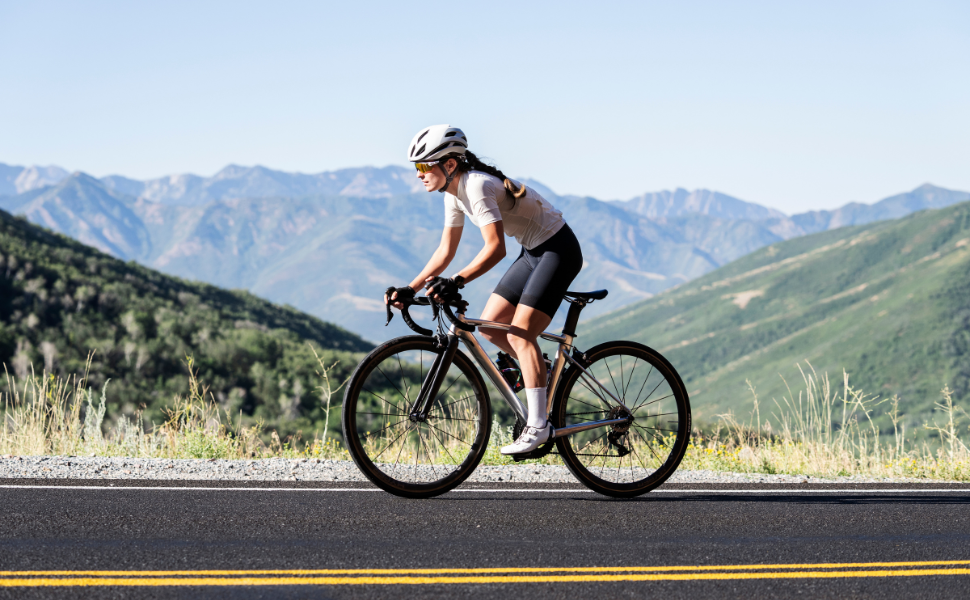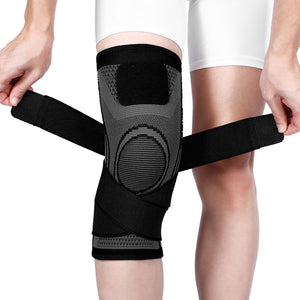Should I Wear a Knee Brace While Cycling?

Cycling has long been popular and is approached by many as a positive and beneficial form of exercise. It is not only a way to exercise but also provides various health benefits, such as improving cardiovascular health and mental well-being.
Whether it is enjoyed as a hobby through scenic routes or pursued sports, cycling continues to attract individuals of all ages, celebrating its ability to combine fitness with adventure.
Cycling is a low-impact exercise. However, it does place a certain amount of stress on the knee joint. Have you ever thought, “Should I wear a knee brace while cycling?”
The knee joint is essential for effective pedaling motion, and repetitive movements can lead to overuse injuries or exacerbate the injuries.
To decrease the risks to the knee joint, cyclists often use a knee brace for cycling. So, if you are wondering, “Should I wear a knee brace while cycling?” then go ahead to learn more!

What are the Risks Associated Cycling?
Cycling is a rewarding and pleasant activity, but like everything else, it comes with inherent risks that can affect the safety of riders.
These risks include complex road conditions, such as intersections and crossings, where cyclists are more likely to encounter unpredictable traffic patterns and potential collisions. Wet roads can also reduce traction, which makes it easier to skid and harder to brake effectively.
Extreme weather conditions can impact visibility for both cyclists and oncoming traffic. Equipment malfunctions, such as sudden tire blowouts, can result in loss of control and falls, particularly at high speeds.
Some cyclists also encounter chain issues, such as a broken or slipped chain, that can cause abrupt stops. In order to overcome all these factors while cycling, it is important to wear helmets, reflective gear, a bicycle knee brace, and regularly maintain the bike.
What are Common Injuries During Cycling?
Various injuries to the knee can occur during cycling, some of which are discussed below. Before we answer the question, ‘Should I wear a knee brace while cycling?’ Let’s first explore some of the most common knee injuries induced by cycling.
1. Iliotibial Band Syndrome (ITBS)
ITBS is an overuse injury of the knee that adversely affects the iliotibial band, which is a thick band of tissues that runs from the hip to the knee's outer part. It occurs when this band becomes tight or inflamed because of repetitive motion.
It causes swelling or a snapping sensation on the outer part of the knee. ITBS also causes pain on the outside of the knee, which may radiate all the way up to the thigh.
2. Patellofemoral Pain Syndrome (PFPS)
Patellofemoral Pain Syndrome (PFPS) is often referred to as "runner's knee" or "cyclist's knee." It is a common overuse injury of the knee that causes pain around the front of the knee and the patella (kneecap).
This condition usually happens when the patella fails to move smoothly, resulting in irritation of the underlying structures.
3. Meniscal Injury
A meniscal injury occurs when there is a tear in one of the menisci due to degenerative changes. A meniscus refers to one of the two C-shaped pieces of cartilage in the knee.
The menisci are shock absorbers between the femur (thighbone) and the tibia (shinbone). They provide cushioning and stability for the knee joint.
Meniscal injuries occur in pain, swelling, tenderness, stiffness, and locking of the knee.
4. Knee Osteoarthritis
Knee osteoarthritis is a type of degenerative joint disease in which the cartilage that wraps the kneecap and provides cushioning to the ends of the bones wears away.
It is a wear-and-tear injury that happens with repetitive cycling motion over time. It leads to pain, swelling, and a reduced range of motion in the knee. Some individuals also experience crepitus, a popping sound or sensation during knee movement.
Why a Knee Brace for Cycling is Needed?
There are many reasons for cyclists to invest in the correct knee support for bike riding and cycling. Learn more about the reasons behind “Should I wear a knee brace while cycling?”
1. Incorrect Riding Posture Causes Injury
Incorrect riding posture may cause inappropriate pressure on our bodies, especially the knees. For example, excessive knee extension or an improper bending angle can increase the risk of injury. A knee brace for mountain biking helps with appropriate muscle balance.
Cycling with a knee brace can aid in stabilizing the knee, which ensures proper alignment and reduces strain during cycling. Repetitive cycling motion combined with poor posture can lead to overuse injuries like patellofemoral pain syndrome (PFPS) or iliotibial band syndrome (ITBS). Therefore, a bicycle knee brace provides adequate support by promoting better knee mechanics.
2. Injured Knee
If the rider has already suffered knee injuries, such as ITBS, PFPS, meniscus injury, and knee osteoarthritis, knee pads can provide necessary protection and support.
A knee brace for exercises helps stabilize the knee joint, limit excessive activity, and reduce the risk of further injury.
For injured knees, bicycle knee braces can also provide warmth and compression, helping to reduce swelling and pain.
3. Older Cyclists
For older cyclists, age-related weakening of muscles and degeneration of ligaments can lead to joint instability in the knee. A bicycle knee brace aids in maintaining joint stability, reducing the risk of injuries.

What are the Benefits of Cycling with Knee Brace?
If you still doubt, “Should I wear a knee brace while cycling?” Here are some of the benefits of having a brace:
- Protection and Prevention: The main function of knee braces is to protect the knees from impacts and falls. When cycling, knee pads can slow down the impact force and reduce direct damage to the knees. Knee braces can also help prevent chronic injuries caused by improper riding postures, such as PFPS and ITBS.
- Keep Warm: Knee braces can provide warmth to the knees, helping to maintain muscle temperature and thereby reducing the risk of injury. Moreover, the warm temperature provides muscles and ligaments with the necessary environment to recover.
- Reduce Knee Pressure: Wearing a knee brace while cycling reduces impact and pressure on the knee. It can aid in the protection of the joint from unnecessary stress.
- Improved Blood Circulation: Better circulation with a knee brace can help deliver oxygen and nutrients to the muscles. Improved oxygen transport improves performance and reduces the risk of muscle cramps. Now, you may know the answer to the question, “Should I wear a knee brace while cycling?”
Where to Buy a High-quality Knee Brace for Cycling?
How to choose a knee brace? Many bicycle knee braces provide support and comfort while cycling, but choosing the right fit for yourself is essential.
1. Fivali Adjustable Knee Brace for Pain 2 Pack FKR02
This knee brace has a secure Velcro fastening, which allows users to loosen or tighten the guard according to their size preference (available in 4 sizes: S, M, L, and XL) and comfort level while providing reliable stability and support.
It has elastic spring stabilizers that provide additional cushioning and protection, especially during high-impact activities or sports.
These knee braces also have a patellar gel pad that acts as a shock absorber to reduce pressure on the knee joint. They provide cushioning and support, minimizing the risk of injuries such as meniscal tears and patellofemoral pain syndrome.
The cross-strap compression design also adds maximum comfort while ensuring the knee brace for cycling fits perfectly onto the knee to protect us.
2. Fivali Sport Compression Knee Support FKR13
This knee support offers durable construction as the high-quality knee pads are made with materials that can withstand repetitive use while offering long-lasting protection.
The FKR13 is designed to resist wear and tear while providing reliable joint support for extended periods. They have a T-shaped spring bar, which offers balanced compression and aids in distributing the weight evenly over the joint.
The knee support for bike ridding also offers cushioning with an extra layer to absorb impact and reduce pressure on the knees, making it ideal for cycling activities that involve impact.
The knee pads have a non-slip silicone strip to provide an excellent grip that helps eliminate instability during movement.

Conclusion
Should I wear a knee brace while cycling? Now, you may have the answer. Cycling is a healthy and enjoyable activity. Bicycle knee braces not only increase cycling safety but also enhance riding comfort and efficiency. For all cyclists, whether it is leisure riding or participating in competitions, it is a worthwhile investment to consider. Visit Fivali’s website to find more options!













